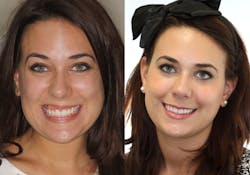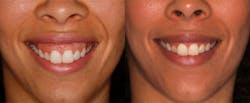Facial injections: Why you should incorporate botulinum toxin into your dental practice (part 1)
DENTISTRY ISN’T CHANGING. IT HAS CHANGED. Forty years ago, amalgam fillings were the norm, and patients weren’t concerned with achieving white teeth via bleaching. Twenty years later, composite bonding and teeth whitening options were on trend. Today, they are the new standard.
Even just 10 years ago, porcelain-fused-to-metal crowns were still predominant. In recent years, advances in the digital and material worlds have shifted doctor and patient demands to all-ceramic options—another new standard. Dentistry is constantly evolving to address both cosmetic and functional issues. These advancements expand our scope of practice, improve the quality of care we’re able to offer, and improve our patients’ quality of life.
Botulinum toxin (available as Botox, Dysport, or Xeomin) was originally developed in the 1970s to treat strabismus or misalignment of the eyes. It has since been used to address a growing number of functional and esthetic issues, and it is quickly becoming a part of the modern dental practice due to its tremendous ability to help patients both cosmetically and functionally. What has been a new trend will soon become a standard as patients increasingly turn to their dental providers for these treatments.
My journey with botulinum toxin and dermal fillers began seven years ago when I decided to train in facial injectables. I refreshed my knowledge of facial anatomy, reviewed the appropriate literature, and shadowed expert injectors. Soon afterward, I introduced Botox into our dental practice.
Esthetically, I use botulinum toxin in both the upper and lower face to rebalance specific muscles and reduce skin wrinkles or to subtly improve the positioning of the overlying soft tissue. The goals of upper-face treatment include reducing crow’s-feet around the eyes, reducing vertical frown lines between the eyebrows, reducing horizontal "worry lines" on the forehead, and lifting or sometimes arching the eyebrows (figure 1).
Figure 1: Before and after photos show the results of using botulinum toxin for upper-face treatment.
In the lower face, carefully placed botulinum toxin can make dramatic changes to the frame of our patients’ smiles. Injection of specific lower-lip muscles can reverse downturned oral commissures and reduce the appearance of a resting frown. Additionally, the dynamic nature of the orbicularis oris muscle inevitably leaves its mark in the overlying skin in the form of stubborn vertical lip lines or perioral rhytids. Using small, targeted injections of botulinum toxin can calm the hyperdynamic muscle, resulting in a smoother, softer, and more youthful lip and smile.
Finally, the appearance of a gummy smile can be minimized or eliminated using targeted treatment with botulinum toxin to the lip elevators (figures 2 and 3). In one implant reconstruction, we used this technique to help hide an unesthetic situation and minimize the patient’s cosmetic concerns during the transitional phase.
Figure 2: Before and after photos illustrate how targeted treatment using botulinum toxin can help to eliminate the appearance of a gummy smile.
Figure 3: Another case shows how botulinum toxin can be used help to eliminate the appearance of a gummy smile.
Functionally, botulinum toxin adds value to our practice in helping patients suffering from TMD with a muscular component. While botulinum toxin is no substitute for a well-adjusted occlusal guard, many patients are noncompliant or simply unable to stop clenching, even with this therapy. Botulinum toxin injected into the masseter and/or temporalis muscles reduces these muscles’ strength and size, appropriately weakening their bite force and reducing clenching and grinding. Patients report less jaw tension, fewer headaches, and a noticeably slimmer appearance in the contour of their face.
Facial injectables now account for roughly 50% of my practice's production, and I enjoy seeing injectables on my schedule. Over time, I have progressed from offering straightforward botulinum toxin therapy with Botox to addressing patients’ total facial esthetic and functional issues using a combination of botulinum toxin and dermal fillers. Each patient’s case is unique and requires careful thought, planning, and creativity with a delicate touch, which challenges and stimulates me while also fulfilling my artistic inclinations.
I have found that injectable patients want to be in my chair and want the treatments—a nice feeling that is not common in everyday dentistry. Treatments take 10 to 30 minutes, and results appear in one to four days with botulinum toxin and almost immediately with dermal fillers. That same wow effect you get when your patient sees his or her new smile for the first time is the same wow effect you get each and every time you hand a patient the mirror after an injectables session. It is wonderfully rewarding. Patients receive near-instant gratification, and they appreciate being able to pop in for a treatment that offers fast and noticeable results, which helps fill holes in our schedule.
In our practice, injectables boost staff esprit de corps; staff members often want these procedures done on themselves, and they are eager to share their enthusiasm and results with patients. Throughout the year, our staff helps set up and run injectable parties and promotional events, generating a buzz in the practice, which helps us recruit more patients.
Our practice has benefited from adding injectable procedures—patients who initially come in for facial esthetic treatments often end up becoming our dental patients and vice versa. This synergy of dental and facial esthetic procedures allows us to be more comprehensive in our treatment planning. It enables us to offer what many call “total facial aesthetics” to our patients.
As our patients become more aware of the esthetic value of dentistry, we have the opportunity to branch out beyond the teeth. Aside from your investment in proper training, you don't even need to purchase any big-ticket items to get started—just a few basic supplies, such as insulin needles, alcohol swabs, and marking pencils. If you are looking for a new dynamic that will challenge you and allow you to offer more to your patients, then facial injectables might be right for your practice. Approached conservatively, these treatments are safe, minimally invasive, and most of all, fun for you and the patients.
Editor's notes: This article is the first in a four-part series about facial injections in the dental practice. The next installment will appear in the October 25 issue of Pearls for Your Practice: The Product Navigator. Click here to subscribe. Click here to submit a products article for consideration.
Tracy Shaw Blessing, DMD, maintains a private practice in Miami Beach, Florida. She provides Botox and dermal filler seminars, certification courses, original marketing, and media and consulting services. To learn more about small-group and private training opportunities, contact her at [email protected], or visit her website at tracyshawblessing.com.








